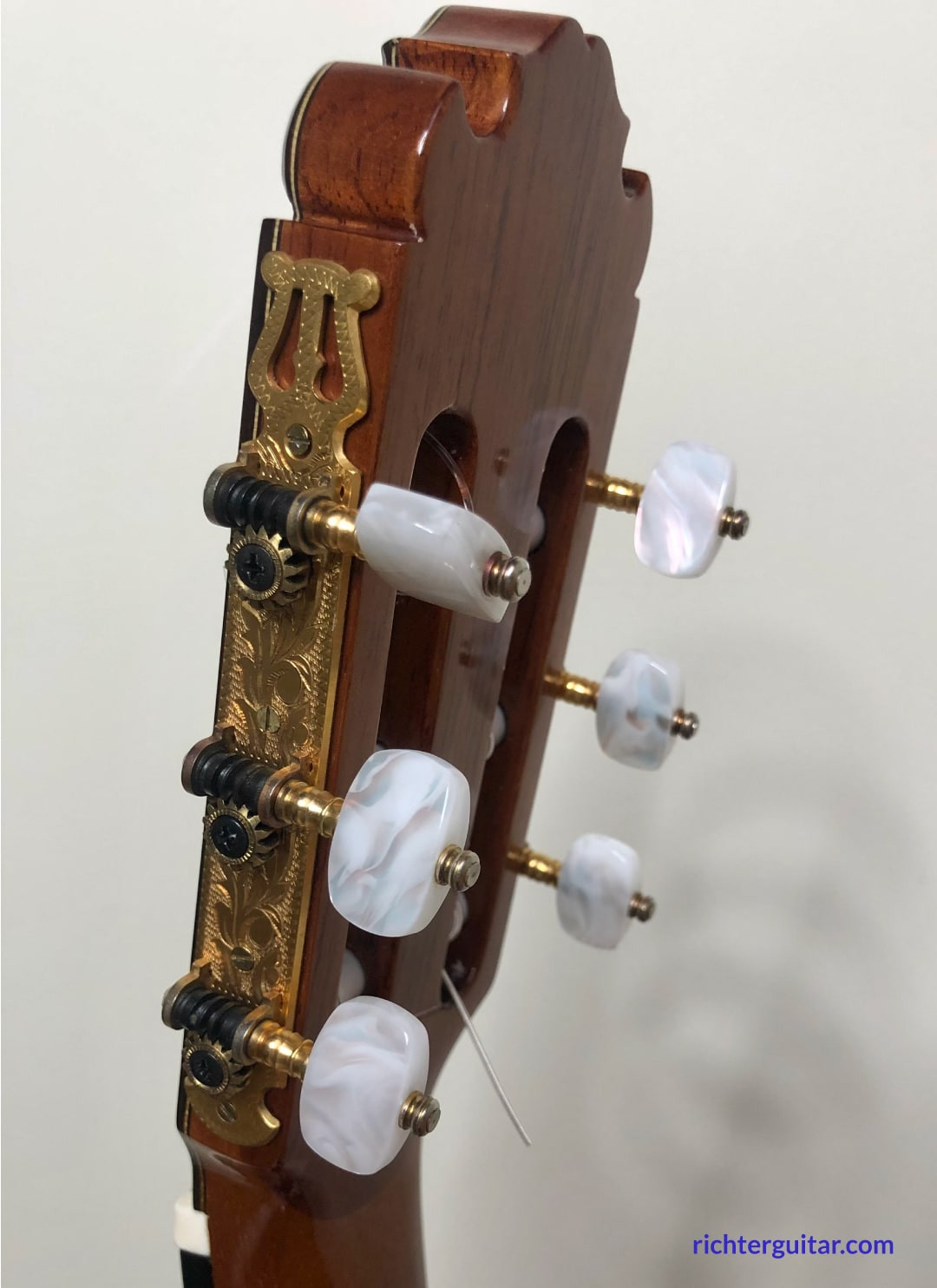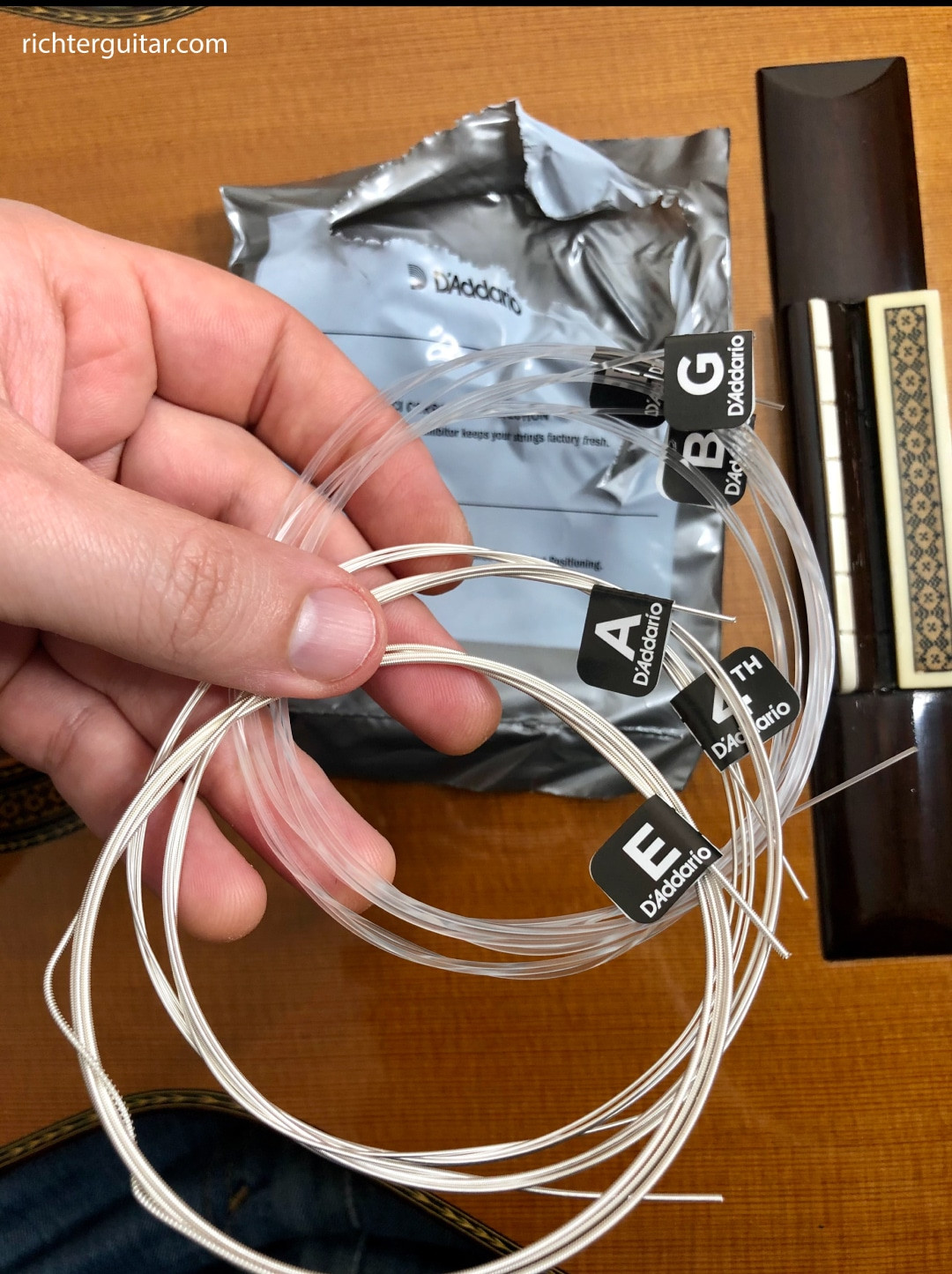Understanding the anatomy of your classical guitar is fundamental, whether you’re just starting your musical journey or aiming to deepen your knowledge. Knowing the name of each guitar part not only enhances your communication with fellow musicians and luthiers but also provides a deeper appreciation for the instrument itself. This guide will walk you through each component of the classical guitar, detailing its function and significance in producing beautiful music.
Just like understanding the different parts of a car helps you appreciate its engineering, learning about the parts of a guitar unveils the craftsmanship and design that goes into creating its unique sound. We’ll explore the exterior components of the guitar, categorized into three main sections: the headstock, the neck, and the body. Each area plays a vital role in the guitar’s construction, playability, and overall tonal character.
From the meticulously crafted headstock to the resonant body, every part of the guitar is designed with purpose and contributes to its distinctive voice. Let’s dive in and Name The Parts Of The Guitar, starting from the top and working our way down.
 Jonathan Richter thumbnail on Parts of the Guitar YouTube Short
Jonathan Richter thumbnail on Parts of the Guitar YouTube Short
1. The Headstock: Where Tuning Begins
The headstock, often simply called the head, is located at the very top of the guitar and is crucial for stringing and tuning the instrument. It’s arguably one of the most visually distinctive parts of a guitar, often showcasing the luthier’s artistry and brand.
1.1 Tuners (Machine Heads): Adjusting the Pitch
Also known as machine heads, tuning pegs, or tuning machines, the tuners are geared mechanisms mounted on the headstock. Their primary function is to adjust the tension of the strings, thereby altering their pitch. By turning the tuner buttons, you can precisely tighten or loosen each string to achieve accurate tuning. Classical guitars typically feature geared tuners for smooth and stable adjustments. These tuners are usually arranged in two sets of three, one on each side of the headstock.
 classical guitar tuning pegs/machine heads
classical guitar tuning pegs/machine heads
1.2 String Rollers: Guiding the Strings
String rollers are cylindrical parts attached to the tuners that pass through the headstock. Each string is threaded through a hole in its corresponding roller. As you rotate the tuner, the string roller turns, winding the string around itself and increasing or decreasing its tension. This direct mechanical action allows for fine-tuning of each string’s pitch.
2. The Neck: The Guitarist’s Domain
The neck is the long, slender piece of wood that extends from the headstock to the body of the guitar. It’s the area where the guitarist’s left hand (or right hand for left-handed players) interacts with the strings to produce different notes and chords. The neck’s dimensions and characteristics significantly impact playability and comfort.
2.1 Nut: The String Spacer at the Headstock
Positioned at the junction of the headstock and the neck, the nut is a small, typically bone, plastic, or composite piece with grooves that guide and space the strings. The nut ensures proper string alignment as they transition from the headstock to the fingerboard. It also plays a role in setting the string height, or action, at the headstock end of the neck. Adjusting the nut can affect the overall playability and comfort of the guitar.
2.2 Fingerboard (Fretboard): Mapping the Notes
The fingerboard, also known as the fretboard, is the flat strip of wood that sits atop the guitar neck. It’s the surface against which the player presses the strings to shorten their vibrating length and produce different notes. Classical guitar fingerboards are typically made of ebony due to its hardness and smooth texture. Unlike some steel-string guitars, classical guitars usually have a flat fingerboard radius, although some modern crossover models may feature a slight radius for enhanced playability for some guitarists.
2.2.1 Flat vs. Radiused Fingerboards: A Matter of Preference
Classical guitars traditionally feature a flat fingerboard, providing a consistent surface across all strings. This contrasts with radiused fingerboards found on many steel-string acoustic and electric guitars, which are slightly curved. The choice between flat and radiused is often a matter of player preference and playing style. Flat fingerboards are generally favored for classical guitar technique, while radiused boards can be more comfortable for barre chords and certain hand positions for some players transitioning from other guitar types.
2.2.2 Standard vs. Elevated Fingerboards: Reaching New Heights
Most classical guitars have a standard fingerboard that is close to the guitar’s top. However, the elevated fingerboard is an innovation designed to improve access to the higher frets, typically beyond the 12th fret. By raising the fingerboard above the soundboard, it provides more space for the guitarist’s hand to reach these higher positions comfortably. Some luthiers also believe that elevated fingerboards can contribute to improved tone and resonance.
2.3 Frets: Dividing the Musical Scale
Frets are the thin metal strips embedded across the fingerboard, perpendicular to the strings. They precisely divide the fingerboard into semitone intervals. When a string is pressed down behind a fret, the fret acts as the new termination point of the string, effectively shortening its vibrating length and producing a specific pitch. Classical guitar frets are typically made of nickel-steel or stainless steel and are wider and slightly less tall than those found on steel-string guitars, accommodating the wider nylon strings.
2.4 Heel (Spanish Heel): Neck-Body Joint
The heel is the point where the neck joins the body of the guitar. In traditional Spanish-style guitar construction, a “Spanish heel” is employed. This method involves integrating part of the neck block inside the guitar body during construction, creating a very stable and resonant neck joint. The Spanish heel is considered a hallmark of high-quality classical guitar construction, contributing to the instrument’s structural integrity and sound.
3. The Body: The Soul of the Guitar’s Sound
The body is the largest part of the guitar and acts as the primary resonating chamber, amplifying the vibrations of the strings into audible sound. It’s comprised of the soundboard (top), back, and sides, each contributing uniquely to the guitar’s tone and volume. The body’s shape, size, and the woods used in its construction are crucial factors in determining the guitar’s overall sonic character.
3.1 Soundboard (Top): The Primary Voice
The soundboard, or top, is widely regarded as the most critical component influencing the guitar’s tone. It’s the primary vibrating surface that responds to the strings’ energy and projects sound. Classical guitar soundboards are typically made of spruce or cedar. These woods are chosen for their excellent resonance, flexibility, and strength-to-weight ratio. The soundboard’s bracing pattern underneath also plays a significant role in shaping the guitar’s sound.
3.1.1 Spruce vs. Cedar Soundboards: Tonal Personalities
Spruce and cedar are the most common tonewoods for classical guitar soundboards, each offering distinct tonal characteristics. Spruce generally provides a brighter, clearer, and more powerful tone with excellent projection and dynamic range. Cedar, on the other hand, typically produces a warmer, mellower, and more immediate sound, often favored for its responsiveness and richness of tone, particularly for players with a lighter touch. The choice between spruce and cedar often comes down to personal preference and the desired tonal qualities.
3.2 Sound Hole: Projecting the Resonance
The sound hole is the circular opening in the soundboard, usually located beneath the strings. It serves as the primary outlet for the sound produced by the vibrating soundboard and the resonating air within the guitar body. Without the sound hole, the sound would be trapped inside the body, significantly reducing the guitar’s volume and projection. The sound hole’s size and placement can subtly affect the guitar’s tonal characteristics.
3.3 Rosette: Decorative and Functional Artistry
The rosette is the decorative inlay that encircles the sound hole. Historically, it was believed to reinforce the soundboard around the sound hole, preventing cracks. Today, the rosette is primarily an aesthetic feature, showcasing the luthier’s craftsmanship and adding visual appeal to the guitar. Rosettes can range from simple, classic designs to intricate, elaborate patterns, often reflecting the luthier’s personal style or the guitar’s origin.
3.4 Bridge: Anchoring the Strings to the Body
The bridge is located on the soundboard below the sound hole and serves as the anchor point for the strings on the body of the guitar. It transfers the strings’ vibrations to the soundboard, causing it to resonate. The bridge is typically made of rosewood or other dense hardwoods and consists of several parts, including the bridge base, saddle slot, and saddle. Classical guitar strings are tied to the bridge in a specific manner to ensure secure attachment and proper sound transmission.
3.5 Saddle: Fine-Tuning String Height at the Bridge
The saddle is a small strip, usually made of bone, plastic, or similar material, that sits in the saddle slot on the bridge. The strings rest on top of the saddle, which elevates them slightly above the bridge. Like the nut, the saddle plays a role in determining the string action, this time at the body end of the guitar. Adjusting the saddle height is a common way to fine-tune the guitar’s playability and string action.
3.6 Back and Sides: Shaping the Resonance Chamber
The back and sides of the guitar body enclose the resonating chamber and contribute significantly to the instrument’s tone, projection, and sustain. The woods used for the back and sides, along with the body’s shape and depth, influence how sound waves reflect and interact within the guitar. Common tonewoods for the back and sides include rosewood, mahogany, maple, and cypress, each imparting unique tonal characteristics.
3.6.1 Rosewood, Maple, Cypress, and Beyond: Tonewood Choices
Rosewoods, particularly Brazilian and Indian rosewood, are highly prized for guitar backs and sides due to their rich, warm, and complex tonal qualities, offering excellent sustain and projection. Maple provides a brighter, clearer, and more focused tone, often favored for its clarity and responsiveness. Cypress is traditionally used in flamenco guitars, known for its bright, percussive, and quick response, ideal for the flamenco style. Beyond these, many other woods are used, each contributing unique sonic colors and aesthetic qualities to the instrument.
4. Guitar Strings: The Source of Sound
While technically not a permanent part of the guitar’s construction, strings are obviously essential for producing sound. Standard classical guitars use six nylon strings, although 7, 8, and even 10-string classical guitars exist. The strings are tuned to E, A, D, G, B, E, from lowest to highest pitch. Classical guitar strings are made of nylon, with the bass strings wound with metal, typically silver-plated copper. Different string tensions and materials can significantly affect the guitar’s sound and playability.
 D
D
Conclusion: Appreciating the Harmony of Parts
By now, you should be well-versed in naming the parts of the guitar and understanding their individual roles in creating music. Each component, from the tuners on the headstock to the bridge on the body, works in harmony to produce the unique and beautiful sound of the classical guitar. This knowledge not only enriches your playing experience but also deepens your appreciation for the instrument’s intricate design and craftsmanship.
This guide has focused on the exterior parts of the classical guitar, but there’s a whole world of internal construction and bracing patterns that further contribute to its sound. Exploring these aspects can lead to an even greater understanding of this fascinating instrument.
Ready to take your guitar journey further? Explore our Guitar Foundations course for step-by-step lessons to build a solid playing technique and deepen your musical understanding.
View Course
[
